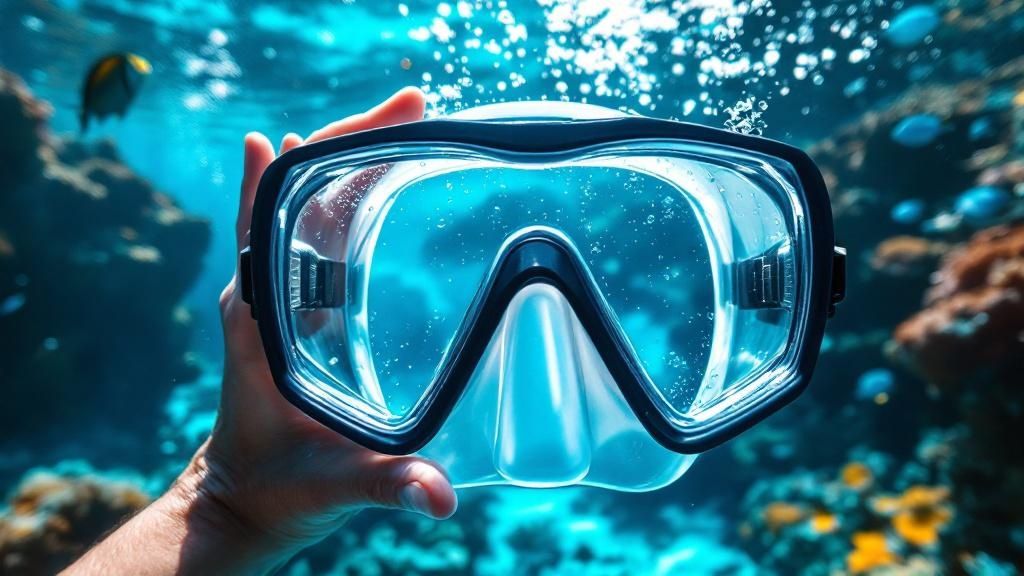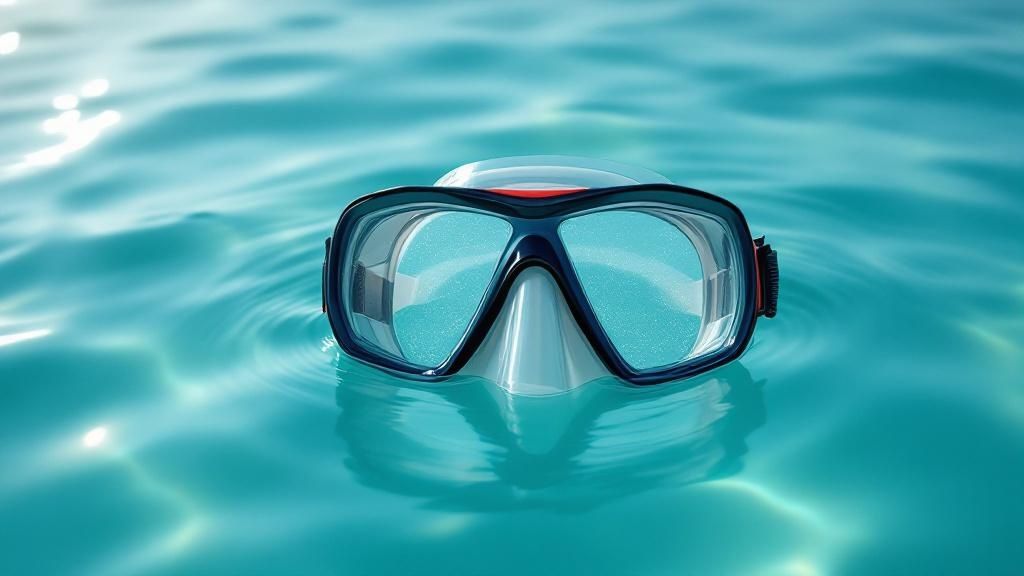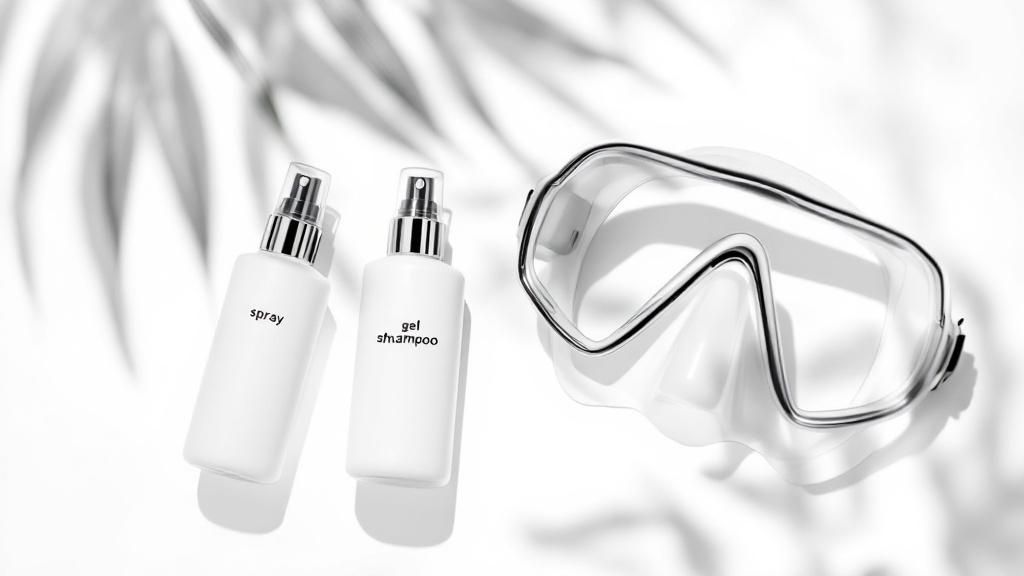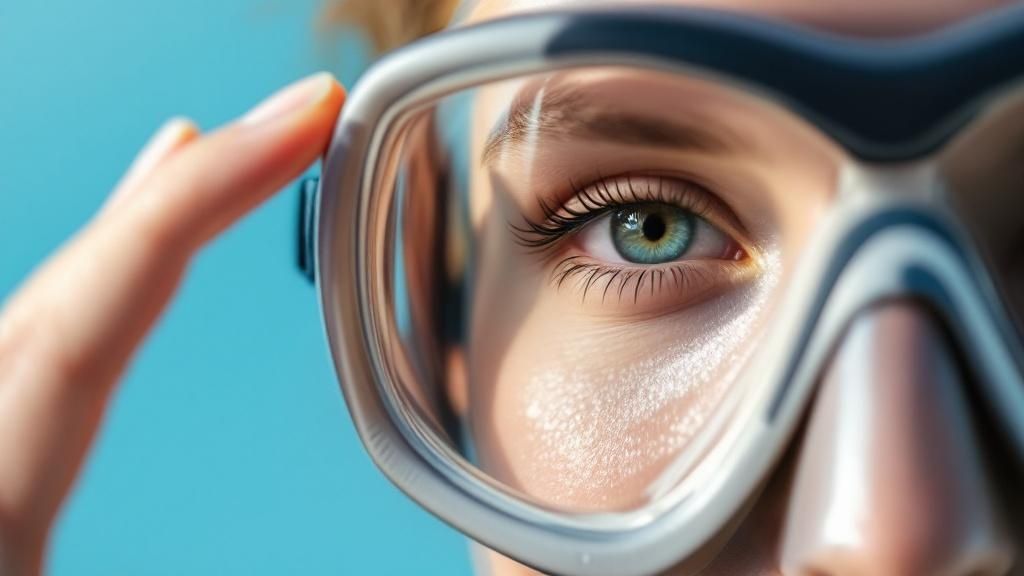Effective Anti Fog for Snorkel Mask – Clear Vision Guaranteed

A foggy snorkel mask can turn a jaw-dropping underwater world into a frustrating, blurry mess. I’ve seen it happen countless times. One minute you’re about to lock eyes with a sea turtle, the next you’re just staring at your own breath.
The secret to a consistently clear view isn't just one thing. It's a two-step combo: a one-time prep for any new mask you buy, and a quick defog ritual you'll do right before you hop in the water, every single time. Get this down, and you'll never miss a moment.
Why Your Snorkel Mask Fogs Up

So what’s actually happening inside your mask? It’s pretty simple science. The air you breathe out is warm and full of moisture. When that humid air hits the cooler glass of your mask lens, the water vapor condenses into thousands of tiny droplets. That's your fog. Think of it like a cold glass of water on a hot summer day.
Trying to spot a camouflaged octopus or appreciate the vibrant colors of a coral reef through a fogged-up lens is a total non-starter. But it's more than just a bummer—a clear view is critical for safety, helping you keep track of your surroundings and your snorkel buddy.
The Hidden Problem with New Masks
If you've just bought a brand-new mask, you're dealing with an extra layer of frustration. Straight from the factory, the inside of the glass lens is coated with a thin, invisible film of silicone residue. This stuff is a moisture magnet and the number one reason new masks fog up relentlessly.
No amount of defogger will work properly until you scrub that film off. Seriously, this is a non-negotiable first step for any new mask. Don't skip it.
Your Pre-Dive Ritual for Clear Vision
Once you've dealt with the factory film, you still need to apply a defogging agent before every snorkel. This simple step creates a super-thin, water-loving layer on the lens. Instead of beading up into fog, any condensation flattens out into a transparent sheet of water that you can see straight through. Your main options are:
- Commercial Defoggers: Specially designed gels and sprays that are reliable and effective.
- DIY Solutions: Good old-fashioned diluted baby shampoo is a go-to for many experienced divers.
- The Spit Method: It's the classic, in-a-pinch trick that divers have been using for decades. It works!
The popularity of snorkeling is soaring, and the Anti-fog Diving Masks Market is growing right along with it. This just goes to show how much people value a clear, safe, and enjoyable time in the water. For a deeper dive, you can explore the market trends to see why quality visibility is such a big deal for everyone from casual snorkelers to seasoned divers.
Quick Guide to Anti-Fog Methods
Choosing the right anti-fog method can feel like a bit of trial and error. Some people swear by baby shampoo, while others prefer the convenience of a commercial spray. This table breaks down the most common options to help you decide what's best for your next trip.
| Method | Best For | Pros | Cons |
|---|---|---|---|
| Commercial Gel/Spray | Reliability and ease of use. Great for frequent snorkelers. | Highly effective, long-lasting, designed for masks. | An extra item to buy and carry. |
| Baby Shampoo | DIY enthusiasts and those looking for a budget-friendly option. | Inexpensive, readily available, works well. | Needs to be diluted correctly, can sting eyes if not rinsed. |
| The "Spit" Method | When you're in a pinch and have no other options. | Always available, costs nothing, surprisingly effective. | Less effective than other methods, a bit gross for some. |
| Toothpaste (New Masks) | A one-time pre-treatment for brand new masks only. | Excellent for removing factory silicone residue. | Abrasive; must use non-whitening paste and be careful not to scratch the lens. |
Ultimately, the best anti-fog is the one that works for you and that you'll actually use before every dive. Experiment a little and see what gives you the clearest, most reliable results for your adventures.
The Essential First Step For Any New Mask
So you've just unboxed a brand-new snorkel mask, ready for your next adventure. But hold on. Before you even think about getting it wet, there’s a secret you need to know—one that will make or break your entire snorkeling experience.
Straight from the factory, every new mask lens is coated with a thin, almost invisible film of silicone residue. It’s a normal part of the manufacturing process, but it’s an absolute fog magnet. No amount of defogger, spit, or wishful thinking will work until that film is gone for good. Taking care of this now is the single most important thing you can do to guarantee a lifetime of crystal-clear views.
Prepping Your Lens the Right Way
The best tool for the job is probably sitting in your bathroom right now: good old-fashioned toothpaste.
The trick is to use the right kind. You’re looking for a basic, plain white paste—nothing fancy. Avoid gels, charcoal formulas, or anything with "whitening" crystals. The mild abrasive grit in simple toothpaste is what does the work, scrubbing away that stubborn silicone layer without scratching the tempered glass.
Here’s what to do:
- Squeeze a small, pea-sized amount of the paste onto your fingertip.
- On a completely dry lens, scrub the inside surface vigorously.
- Work in small, firm circles, covering every single inch of the glass. Pay special attention to the edges where the lens meets the silicone skirt.
- Keep scrubbing for a good 2-3 minutes per lens. You should feel the texture under your finger change from slick to slightly grippy as the film lifts off.
Pro Tip: Not sure if you’ve scrubbed enough? Rinse the mask with warm water. If water sheets off the lens smoothly, you’re done! If it still beads up into little droplets, the silicone is still there. Give it another round of scrubbing.
Once you’ve finished, give the mask a thorough rinse with warm water to wash away all the toothpaste residue. With this one-time prep out of the way, your mask is finally ready for a standard anti fog for snorkel mask treatment before each use. To learn more about that, check out our complete anti-fog guide for your snorkel mask.
This simple infographic below really shows why getting rid of that factory film is so critical.

Fog happens when your warm, moist breath hits the cooler glass of the lens, causing condensation. That leftover silicone film gives the water vapor the perfect surface to cling to, fogging you up instantly. By scrubbing it away, you create a clean slate for your anti-fog solution to do its job properly.
Using Commercial Defoggers Like a Pro
When you want a no-fuss, reliable way to keep your mask clear, nothing really beats a quality commercial anti-fog solution. These formulas are made specifically for this job, but believe me, there's a technique to it. Applying it the right way is the difference between a perfect, clear day in the water and a frustrating one where you're constantly fighting fog.
These products are everywhere now, and for good reason. The market for them has grown a ton, which just goes to show how many people are getting into water sports and realizing how vital clear vision is. You can see some of the data on this growth if you're curious.
Gels vs. Sprays: What’s Better?
Your first choice will be between a gel and a spray. Gels are more concentrated, so they create a thicker, more durable anti-fog layer. I find they’re the best bet for long trips or for snorkeling in colder water where fogging gets really aggressive.
Sprays are all about convenience and quick coverage. They're perfect for a casual snorkel in warm, tropical water when you just need a quick application.
Honestly, for most people, I’d point them toward a good quality gel. The staying power is just superior.
Expert Insight: A lot of us seasoned guides and divers lean towards gels. A single, properly applied coat can honestly last for multiple dives or snorkels in one day. The trick is to apply it to a completely dry lens well before you even think about getting wet.
The Correct Application Technique
So, what's the goal here? You're trying to create a super thin, perfectly smooth film on the inside of your lens. This layer is hydrophilic, which is a fancy way of saying it makes condensation sheet off into a flat layer of water you can see right through, instead of beading up into those little vision-blocking fog droplets.
Here’s the simple but absolutely critical method I teach everyone:
- Start with a Dry Lens: Your mask needs to be completely dry and clean. Put a single small drop of gel or one to two spritzes of spray on the inside of each lens. That’s all you need.
- Rub, Don't Just Wipe: Use your fingertip to really rub the solution across the entire inner surface. Work it into all the corners and right up to the edges. You're trying to create a good bond with the glass or plastic.
- A Quick, Light Rinse: Just before you pop your mask on, give it a very brief rinse. I mean a quick dip-and-dump in the ocean or whatever water is handy. You are not trying to wash it off. The goal is just to rinse away the excess, leaving that invisible, magic film behind.
Properly applying your defogger is just one piece of the puzzle. Keeping all your gear in top shape is what guarantees great experiences in the water. You can learn more in our complete guide on how to clean your snorkel gear.
DIY Defogging Tricks That Actually Work

It happens to the best of us. You’re out on the water, excited to jump in, and you realize your bottle of trusty defogger is sitting back on the hotel nightstand. Don't let it ruin your day. Over the decades, seasoned divers and snorkelers have perfected a few DIY methods that get the job done when you're in a pinch.
These aren't just old wive's tales; they're genuinely practical solutions based on simple science to create that crucial anti fog for snorkel mask film. Knowing these tricks means you always have a backup plan, turning a potential disaster into a minor hiccup.
The Baby Shampoo Method
This is probably the most popular and effective trick in the book. A little bit of tear-free baby shampoo is cheap, gentle on your mask, and works wonders at creating a hydrophilic layer that stops condensation from fogging up your lens. The secret is all in the dilution.
- Get the Mix Right: You barely need any shampoo. A good rule of thumb is about one part baby shampoo to ten parts water. A lot of us keep a tiny, pre-mixed dropper bottle of this stuff in our dive bags for emergencies.
- Apply and Rub: Squeeze a few drops of your diluted mix onto the dry inner lens. Now, use your fingertip to rub it around, making sure you coat the entire surface.
- A Quick Rinse: Right before you put your mask on and hit the water, give it a very quick dip-and-dump. You don't want to wash it all out—just get rid of the excess soap. What’s left is a perfect, invisible film.
Why does this work so well? Baby shampoo is a surfactant, just like the commercial stuff. It breaks the surface tension of the water, which forces any condensation to run off in sheets instead of forming thousands of tiny, view-obstructing fog droplets.
The Classic Spit Method
Okay, it might sound a little gross, but spitting in your mask is a classic for a reason: it absolutely works when you have nothing else. Your own saliva has enzymes that act as a natural surfactant, giving you a temporary—but surprisingly effective—anti-fog layer.
For this to work, the lens has to be dry. Just work up some spit, apply it to the inside of the glass, and use your finger to rub it in thoroughly. Just like with the shampoo method, a quick rinse right before you put it on clears the excess but leaves the film behind. It won’t last as long as baby shampoo, but it’s a true lifesaver when you’re out on a boat with no other options.
Common Defogging Mistakes to Avoid

You followed all the steps, carefully applied your chosen anti fog for snorkel mask solution, and hopped in the water, only to have your vision cloud over halfway through your snorkel. What gives?
Nine times out of ten, it’s not the defogger’s fault. It usually comes down to a few small, easy-to-fix mistakes that trip up even seasoned snorkelers.
The biggest offender is also the most natural instinct: touching the inside of your lens after you’ve prepped it. Your fingertips are covered in natural oils that will instantly demolish that thin anti-fog film you just created. What’s left is a greasy spot that condensation just loves to cling to.
Another common blunder is rinsing way too aggressively. Whether you’re using baby shampoo or a commercial defogger, all you need is a quick, gentle dunk and swish. Blasting the lens with high pressure or sloshing it around for too long just sends all your hard work right down the drain.
Prepping for Your Environment
Sometimes, you are your own worst enemy when it comes to fog. Slapping a perfectly prepped mask onto a hot, sweaty face is a guaranteed recipe for instant fog-up. The sudden blast of heat and moisture from your skin can overwhelm the anti-fog layer before it even stands a chance.
The easy fix? Just before you put on your mask, splash your face with cool ocean water to bring your skin temperature down. It sounds simple, but it makes a massive difference, especially on those hot, humid Hawaiian days.
Key Takeaway: Once that mask is on, leave it on. I see it all the time—people pulling their mask up onto their sweaty forehead to talk, then pulling it back down. Every time you do that, you're just introducing more moisture and oil, completely undoing your careful prep.
Using the Right Tools for the Job
Not all products are created equal, and grabbing the wrong one can do more harm than good. This is especially true when you're prepping a brand-new mask. A classic mistake is reaching for the wrong kind of toothpaste.
- Wrong Toothpaste: Gel toothpastes just don't have the fine grit needed to scrub off that pesky factory silicone film. And those whitening formulas? They often contain harsh chemicals or big crystals that can permanently scratch your lens. Your best bet is always a basic, non-gel white paste.
- Harsh Soaps: Whatever you do, never use dish soap as a last-minute defogger. It’s designed to cut grease, which means it will slowly eat away at your mask's silicone skirt, causing it to become brittle. Plus, it stings like crazy if you get it in your eyes. Always stick with gentle, tear-free baby shampoo.
By dodging these simple slip-ups, you can make sure the effort you put into treating your mask actually pays off. The goal is a crystal-clear, uninterrupted view of that incredible world just beneath the waves.
Got Questions About Mask Fogging? We've Got Answers
Even when you follow all the steps, a little fog can creep in. It happens to everyone! Don't worry, we've heard just about every question there is when it comes to keeping a snorkel mask clear.
Here are some straight-up answers to the most common problems snorkelers run into. Getting these little details right can be the difference between a crystal-clear view and a frustrating, foggy mess.
Do I Really Have to Use the Toothpaste Trick on a New Mask?
Yes, 100%. If you only do one thing, make it this. Think of it as baptizing your new mask. That slick, invisible silicone film from the factory is the number one reason new masks fog up like crazy, no matter what else you do.
A simple, non-gel, gritty toothpaste is the secret weapon here. It’s the only common household item that really scours that stubborn film off. Without this one-time scrub, even the best anti fog for snorkel mask spray won't stand a chance. You’ll be fighting a losing battle against fog from your very first snorkel.
Can I Just Use Dish Soap Instead of Baby Shampoo?
Please don't. We see this question a lot, and we strongly advise against it. Dish soaps are made with powerful degreasers and chemicals that are just too harsh for your gear. Over time, they can break down the soft silicone skirt of your mask, making it brittle and ruining the seal against your face.
Worse yet, that stuff is a serious eye irritant. "Tear-free" baby shampoo is your best friend here—it’s gentle, pH-neutral, and won't make you cry if a little gets in your eyes. It’s simply the smarter, safer choice for a DIY defogger.
Key Tip: That "tear-free" label isn't just a suggestion. You're putting this stuff right up against your eyes. Using a product designed to be non-irritating is a simple safety step you can't afford to skip.
My Mask Still Fogs Up in the Middle of My Snorkel. What Now?
If fog rolls in while you're already in the water, the quickest fix is to pop your head up. Tip the top of your mask away from your forehead to let a small amount of water in. Swish it around inside the mask—this clears the condensation and helps equalize the temperature. Then, press the mask back to your face and clear the water out by exhaling firmly through your nose.
This is a great in-the-moment fix, but if it keeps happening, it usually points to one of two things: your initial anti-fog layer wasn't thick enough, or it got contaminated with sunscreen or oils from your fingers. Next time you go out, make sure you apply your defogger to a completely dry lens and give it a really good, thorough coating.
For more helpful tips, check out the answers to other common questions about Kona snorkel tours on our frequently asked questions page.
Ready to put your newly acquired fog-free skills to the test on an adventure you’ll never forget? The expert, lifeguard-certified guides at Kona Snorkel Trips are excited to show you Hawaii's most incredible underwater worlds, from stunning coral reefs to the majestic manta rays.
